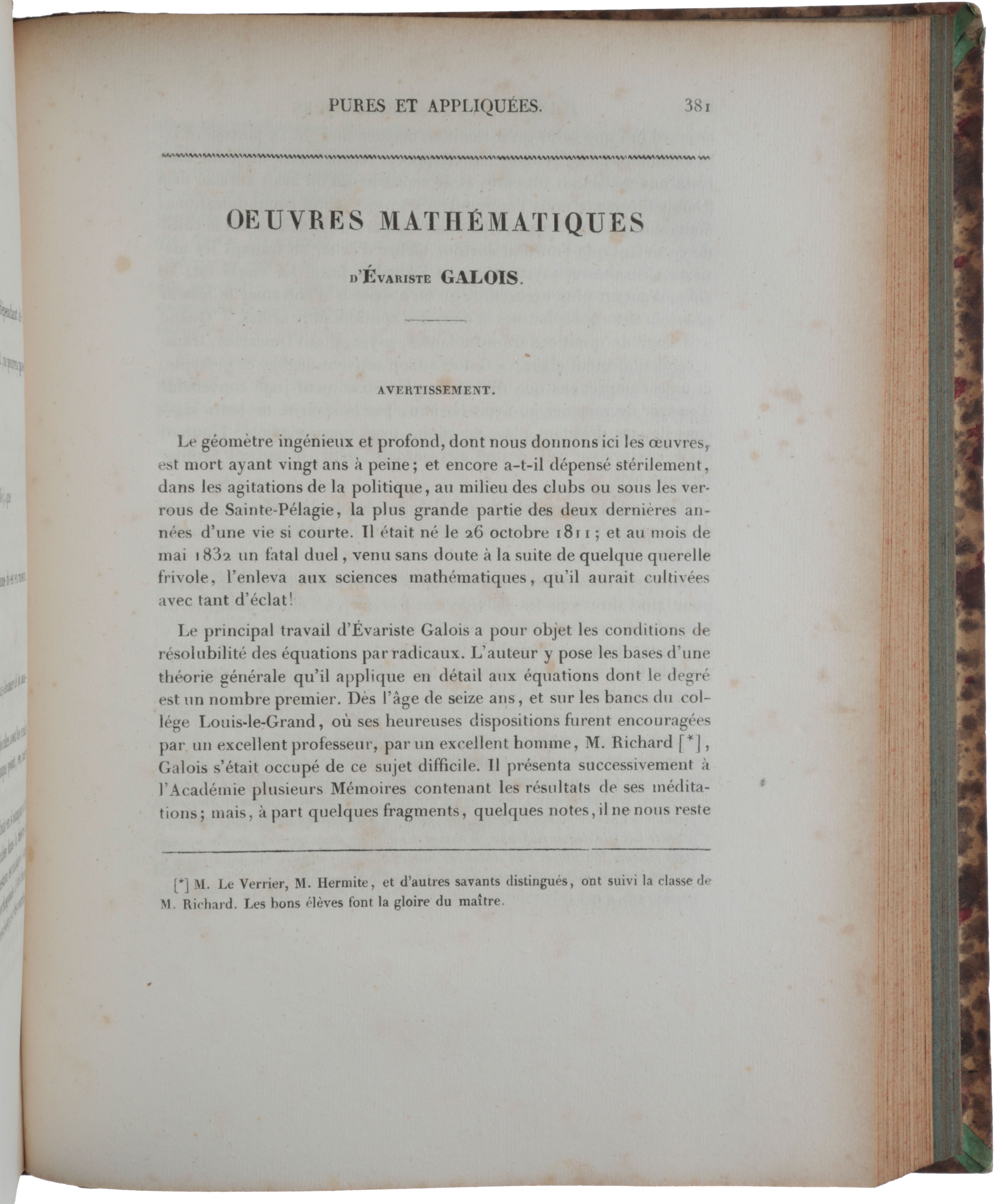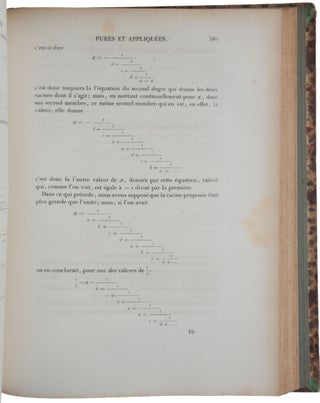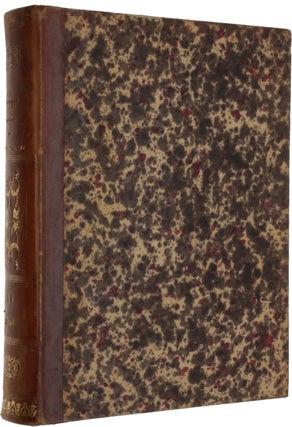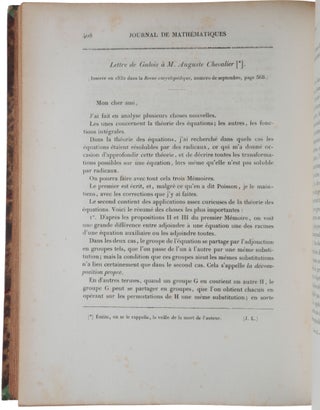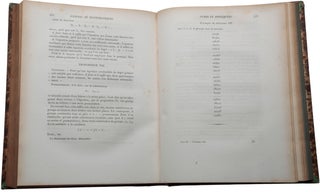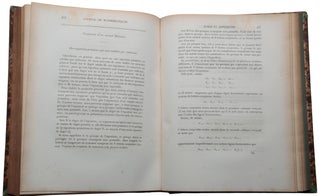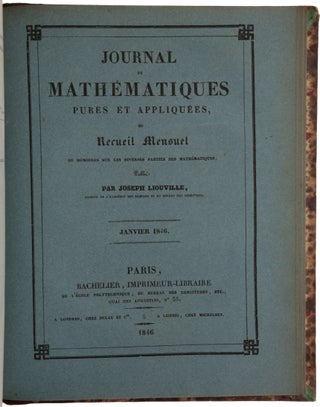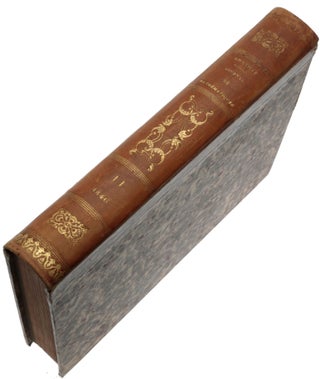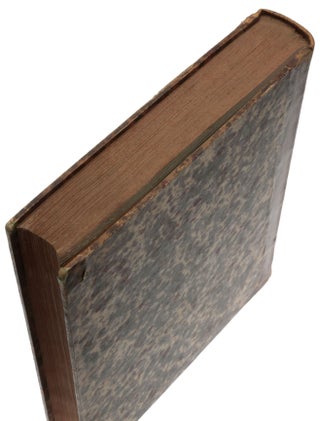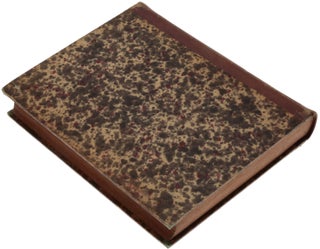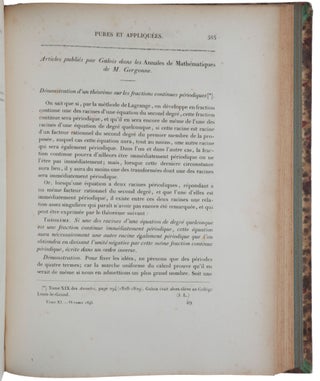Oeuvres mathématiques, pp. 381-444 in: Journal de Mathématiques pures et appliquées ou Recueil mensuel de mémoires sur les diverses parties des mathématiques; publié par Joseph Liouville, Tome XI, Année 1846.
Paris: Bachelier, 1846. First edition of Galois' collected mathematical works, for the most part previously unpublished. Their posthumous publication was due to Joseph Liouville, editor of the leading French journal on pure and applied mathematics. “There have been few mathematicians with personalities as engaging as that of Galois, who died at the age of twenty years and seven months from wounds received in a mysterious duel. He left a body of work – for the most part published posthumously – of less than 100 pages, the astonishing richness of which was revealed in the second half of the nineteenth century. Far from being a cloistered scholar, this extraordinarily precocious and exceptionally profound genius had an extremely tormented life. A militant republican, driven to revolt by the adversity that overwhelmed him and by the incomprehension and disdain with which the scientific world received his works, to most of his contemporaries he was only a political agitator. Yet in fact, continuing the work of Abel, he produced with the aid of group theory a definitive answer to the problem of the solvability of algebraic equations, a problem that had absorbed the attention of mathematicians since the eighteenth century; he thereby laid one of the foundations of modern algebra. The few sketches remaining of other works that he devoted to the theory of elliptic functions and that of Abelian integrals and his reflections on the philosophy and methodology of mathematics display an uncanny foreknowledge of modern mathematics” (DSB). “Évariste Galois created mathematics which changed the direction of algebra. His revolutionary ideas date from around May 1829 to June 1830, the twelve to thirteen months surrounding his eighteenth birthday. An article published in June 1830 created the theory of Galois imaginaries, a fore-runner of what are now known as finite fields; his so-called Premier Mémoire created group theory and Galois Theory—the modern version of the theory of equations. The Lettre testamentaire, the letter that he wrote to his friend Auguste Chevalier on 29 May 1832, the eve of the duel, is an extraordinary summary of what he had achieved and what he might have achieved had he lived to develop and expound more of his mathematical ideas” (Neumann, p. vii). The Oeuvres were considered definitive until 1906; in addition to the memoirs published in Galois’s lifetime (except for the last) and the letter to Auguste Chevalier, this edition contains the following previously unpublished memoirs: ‘Mémoire sur les conditions de résolubilité des équations par radicaux,’ pp. 417–433; and ‘Des équations primitives qui sont solubles par radicaux,’ pp. 434–444. “Galois’s terse style, combined with the great originality of his thought and the modernity of his conceptions, contributed as much as the delay in publication to the length of time that passed before Galois's work was understood, recognized at its true worth, and fully developed … It was only with the publication in 1866 of the third edition of Alfred Serret's Cours d'algébre supérieure and, in 1870, of Camille Jordan's Traité des substitutions that group theory and the whole of Galois's oeuvre were truly integrated into the body of mathematics” (DSB). “In 1828 [Galois] began to study certain recent works on the theory of equations, number theory, and the theory of elliptic functions. This was the period of his first memorandum, published in March 1829 in Gergonne’s Annales de mathématiques pures et appliquées; making more explicit and demonstrating a result of Lagrange’s concerning continuous fractions, it reveals a certain ingenuity but does not herald an exceptional talent. “By his own account, in the course of 1828 Galois wrongly believed—as Abel had eight years earlier—that he had solved the general fifth-degree equation. Rapidly undeceived, he resumed on a new basis the study of the theory of equations, which he pursued until he achieved the elucidation of the general problem with the help of group theory. The results he obtained in May 1829 were communicated to the Académie des Sciences by a particularly competent judge, Cauchy. But events were to frustrate these brilliant beginnings and to leave a deep mark on the personality of the young mathematician. First, at the beginning of July came the suicide of his father, who had been persecuted for his liberal opinions. Second, a month later he failed the entrance examination for the École Polytechnique, owing to his refusal to follow the method of exposition suggested by the examiner. Seeing his hopes vanish for entering the school which attracted him because of its scientific prestige and liberal tradition, he took the entrance examination for the École Normale Supérieure (then called the École Préparatoire), which trained future secondary school teachers. Admitted as the result of an excellent grade in mathematics, he entered this institution in November 1829; it was then housed in an annex of the Collège Louis-le-Grand, where he had spent the previous six years. At this time, through reading Férussac’s Bulletin des sciences mathématiques, he learned of Abel’s recent death and, at the same time, that Abel’s last published memoir contained a good number of the results he himself had presented as original in his memoir to the Academy. “Cauchy, assigned to report on Galois’s work, had to counsel him to revise his memoir, taking into account Abel’s researches and the new results he had obtained. (It was for this reason that Cauchy did not present a report on his memoir.) Galois actually composed a new text that he submitted to the Academy at the end of February 1830, hoping to win the grand prix in mathematics. Unfortunately this memoir was lost upon the death of Fourier, who had been appointed to examine it. Brusquely eliminated from the competition, Galois believed himself to be the object of a new persecution by the representatives of official science and of society in general. His manuscripts have preserved a partial record of the elaboration of this memoir of February 1830, a brief analysis of which was published in Férussac’s Bulletin des sciences mathématiques of April 1830. In June 1830 Galois published in the same journal a short note on the resolution of numerical equations and a much more important article, ‘Sur la théorie des nombres,’ in which he introduced the remarkable theory of ‘Galois imaginaries.’ That this same issue contains original works by Cauchy and Poisson is sufficient testimony to the reputation Galois had already acquired, despite the misfortune that plagued him. The July Revolution of 1830, however, was to mark a severe change in his career. “After several weeks of apparent calm the revolution provoked a renewal of political agitation in France and an intensification in republican propaganda, especially among intellectuals and students. It was then Galois became politicized. Before returning for a second year to the École Normale Supérieure in November 1830, he already had formed friendships with several republican leaders, particularly Blanqui and Raspail. He became less and less able to bear the strict discipline in his school, and he published a violent article against its director in an opposition journal, the Gazette des écoles. For this he was expelled on 8 December 1830, a measure approved by the Royal Council on 4 January 1831. “Left to himself, Galois devoted most of his time to political propaganda and participated in the demonstrations and riots then agitating Paris. He was arrested for the first time following a regicide toast that he had given at a republican banquet on 9 May 1831, but he was acquitted on 15 June by the assize court of the Seine. Meanwhile, to a certain extent he continued his mathematical research. His last two publications were a short note on analysis in Férussac’s Bulletin des sciences mathématiques of December l830 and ‘Lettre sur l’enseignement des sciences,’ which appeared on 2 January 1831 in the Gazette des écoles. On 13 January he began a public course on advanced algebra in which he planned to present his own discoveries; but this project seems not to have had much success. On 17 January 1831 Galois presented to the Academy a new version of his ‘Mémoire sur la résolution des équations algébriques,’ hastily written up at the request of Poisson. Unfortunately, in his report of 4 July 1831 on this, Galois’s most important piece of work, Poisson hinted that a portion of the results could be found in several posthumous writings of Abel recently published and that the remainder was incomprehensible. Such a judgment, the profound injustice of which would become apparent in the future, could only stiffen Galois’s rebellion. “Galois was arrested again during a republican demonstration on 14 July 1831 and placed in detention at the prison of Sainte-Pélagic, where in a troubled and often painful situation he pursued his mathematical investigations, revised his memoir on equations, and worked on the applications of his theory and on elliptic functions. On 16 March 1832, upon the announcement of a cholera epidemic, he was transferred to a nursing home, where he resumed his research, wrote several essays on the philosophy of science, and became involved in a love affair, of which the unhappy ending grieved him deeply. “Provoked to a duel in unclear circumstances following this breakup, Galois felt his death was near. On 29 May he wrote desperate letters to his republican friends, hastily sorted his papers, and addressed to his friend Auguste Chevalier—but really intended for Gauss and Jacobi—a testamentary letter, a tragic document in which he attempted to sketch the principal results he had achieved. On 30 May, mortally wounded by an unknown adversary, he was hospitalized; he died the following day. His funeral, on 2 June, was the occasion for a republican demonstration heralding the tragic riots that bloodied Paris in the days that followed. “Galois’s work seems not to have been fully appreciated by any of his contemporaries. Cauchy, who would have been capable of grasping its importance, had left France in September 1830, having seen only its first outlines. Moreover, the few fragments published during Galois’s lifetime did not give an overall view of his achievement and, in particular, did not afford a means of judging the exceptional interest of the results obtained in the theory of equations and rejected by Poisson. It was not until September 1843 that Liouville, who prepared Galois’s manuscripts for publication, announced officially to the Academy that the young mathematician had effectively solved the problem, already considered by Abel, of deciding whether an irreducible first-degree equation is or is not ‘solvable with the aid of radicals.’ Although announced and prepared for the end of 1843, the publication of the celebrated 1831 memoir and of a fragment on the ‘primitive equations solvable by radicals’ did not occur until the October-November 1846 issue of the Journal de mathématiques pures et appliquées [offered here]. “It was, therefore, not until over fourteen years after Galois’s death that the essential elements of his work became available to mathematicians. By this time the evolution of mathematical research had created a climate much more favorable to its reception: the dominance of mathematical physics in the French school had lessened, and pure research was receiving a new impetus. Furthermore, the recent publication of the two-volume Oeuvres complètes de Niels-Henrik Abel (1839), which contained fundamental work on the algebraic theory of elliptic functions and an important, unfinished memoir, ‘Sur la résolution algébrique des équations,’ had awakened interest in certain of the fields in which Galois has become famous. Lastly, in a series of publications appearing in 1844–1846, Cauchy, pursuing studies begun in 1815 but soon abandoned, had—implicitly—given group theory a new scope by the systematic construction of his famous theory of permutations” (DSB). “Five of Galois’ mathematical papers were published in his lifetime. The most important works, however, are posthumous … The most influential items are: ‘Sur la théorie des nombres,’ published in 1830, in which Galois produced his theory of what used to be called ‘Galois imaginaries’, most of what later became the theory of finite fields; ‘Mémoire sur les conditions de résolubilité des équations par radicaux’, also known as the Premier Mémoire, the paper that was rejected by the Académie des Sciences on 4 July 1831 and returned to its author, but which gave us what we now call Galois Theory; ‘Des équations primitives qui sont solubles par radicaux,’ also known as the Second Mémoire; the letter of 29 May 1832 to Auguste Chevalier known as the Lettre testamentaire” (Neumann, p. 8). “After the publication of Liouville’s edition, Galois’ ideas, though not easily understood in those days, spread steadily through France, Italy and Germany. Liouville had already lectured on them, perhaps in the winter of 1843–44, and Serret had attended. In [Cours d’Algèbre Supérieure, 1849] Serret makes clear that he had not yet understood the ideas, but when he came to publish the much enlarged third edition (1866) he was able to include a pretty full account of the material in the Premier Mémoire. I would guess that his understanding had developed through conversations with his pupil Camille Jordan, who had come to terms with Galois’ ideas in the early 1860s … Jordan’s writings, and especially the great Traité des substitutions et des équations algébriques (1870), show that he had understood Galois’ ideas to the level where he could develop them, as Serret had not … The Traité is described by its author as being nothing but a commentary on the works of Galois … Some commentary! It is 667 quarto pages” (Neumann, p. 10). Neumann, The Mathematical Writings of Évariste Galois, 2011.
4to (250 x 197 mm), pp. viii, 488, some light browning and spotting thoughout. Contemporary calf-backed marbled boards, spine gilt in compartments. All the original blue printed wrappers for each issue bound in at the end.
Item #5255
Price: $12,500.00

